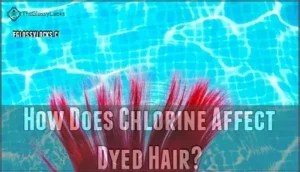This site is supported by our readers. We may earn a commission, at no cost to you, if you purchase through links.
 You just spent hours at the salon getting that perfect vibrant red, and now you’re staring at your pool or planning a beach trip, wondering if one swim will undo all that work. Here’s the reality: chlorine doesn’t play favorites, but it has a particular appetite for red pigments, which can fade up to 20% after just one swim session. Red dye molecules are larger and sit closer to your hair’s surface, making them easier targets for chlorine’s oxidizing effects.
You just spent hours at the salon getting that perfect vibrant red, and now you’re staring at your pool or planning a beach trip, wondering if one swim will undo all that work. Here’s the reality: chlorine doesn’t play favorites, but it has a particular appetite for red pigments, which can fade up to 20% after just one swim session. Red dye molecules are larger and sit closer to your hair’s surface, making them easier targets for chlorine’s oxidizing effects.
The good news? You don’t have to choose between your summer plans and your fresh color. With the right timing—waiting at least 48 to 72 hours lets your cuticles seal properly—and some strategic protection tactics, you can keep that fiery shade looking salon-fresh while still enjoying the water.
Table Of Contents
- Key Takeaways
- Can I Swim After Dyeing My Hair Red?
- How Does Chlorine Affect Dyed Hair?
- How to Protect Red Hair While Swimming
- Can I Swim After Dyeing My Hair Brown?
- How Soon Can I Swim After Using Semi-Permanent Hair Dye?
- Swimming With Permanent Hair Dye
- Swimming With Semi-Permanent Hair Dye
- Swimming With Bleached Hair
- Swimming With Highlighted Hair
- Risks of Swimming With Freshly-Dyed Hair
- Frequently Asked Questions (FAQs)
- What products can I use to protect red hair while swimming?
- Is it safe to swim with permanent hair dye?
- What are the risks of swimming with freshly-dyed hair?
- How does saltwater affect highlighted hair?
- How long does red dye last with regular swimming?
- Can I use purple shampoo on red-dyed hair?
- Should I recolor my hair after multiple swims?
- Conclusion
Key Takeaways
- Red hair dye fades up to 20% after a single swim because red pigment molecules sit closer to the hair surface and oxidize quickly when exposed to chlorine, making them more vulnerable than other colors.
- Wait at least 48 to 72 hours after dyeing before swimming to allow your hair cuticles to seal properly and lock in the color, preventing rapid fading and structural damage.
- Pre-swim protection—like saturating hair with fresh water, applying leave-in conditioner or oil, and wearing a swim cap—creates a barrier that significantly reduces chlorine absorption and color loss.
- Immediate post-swim care with chelating shampoos removes chlorine buildup and mineral deposits that cause brassiness and dullness, helping maintain vibrant red tones between touch-ups.
Can I Swim After Dyeing My Hair Red?
So, when can you actually jump in the water after coloring your hair red—and what’s the real risk if you don’t wait? You need at least 48 to 72 hours before swimming after hair dye, letting the cuticle seal and color set properly.
Red hair dye is especially prone to fading—up to 20% after one swim if you don’t wait. Chlorine impact on red hair happens fast because those dye molecules oxidize easily.
Protecting red hair dye means using a swim cap, pre-swim conditioners, and chelating shampoos for hair care after swimming to help with post-swim color revival.
How Does Chlorine Affect Dyed Hair?
Chlorine doesn’t just fade your color—it actually breaks down the dye molecules themselves through oxidation, causing rapid vibrancy loss. Red hair dye is hit hardest, with color fading rates reaching up to 60% after repeated exposure. That’s because chlorine bonds with keratin proteins in your hair, weakening its structure and opening the cuticle, which makes those red pigments especially vulnerable.
Chlorine breaks down red dye molecules through oxidation, with fading rates hitting 60% after repeated exposure as it weakens keratin proteins and opens vulnerable cuticles
Here’s what chlorine damage really does to dyed hair:
- Keratin protein loss reaches 19–23% after multiple swims, reducing your hair’s strength by up to 30% and leaving it brittle
- Dye molecule oxidation happens fast—red can fade 20% after just one swim, especially within 24 hours of coloring
- Structural hair changes include increased porosity and roughness (up to 40% rougher texture), plus permanent frizz and tangling
Protecting dyed hair means understanding that hair dye and chlorine are natural enemies, particularly for reds. To mitigate these effects, consider using a pre-swim defense product before entering the pool.
How to Protect Red Hair While Swimming
The good news is that you don’t have to skip the pool entirely—you just need to build a solid defense strategy before you even step near the water. Here’s how to keep your red hair vibrant:
- Wear a swim cap that fits snugly to minimize chlorine exposure and lock in your color
- Apply pre-swim treatments like leave-in conditioner or protective oil to create a barrier against chemicals
- Rinse immediately after with fresh water and use a chelating shampoo to remove chlorine buildup
These simple steps for protecting dyed hair while swimming make all the difference in maintaining that bold red you worked hard to achieve.
Can I Swim After Dyeing My Hair Brown?
If brown feels like the safer choice compared to red, you’re not entirely wrong, but that doesn’t mean you can throw caution to the wind just yet. Brown dye types still contain pigments that chlorine can oxidize, leading to brown dye fading and unwanted brassiness.
Your brown hair porosity plays a role here—more porous strands absorb chlorine faster, accelerating color loss. Wait at least 48–72 hours after swimming after hair dyeing to let the cuticle seal properly.
Use color-safe routines like pre-swim treatments and chelating shampoos for hair care after swimming. Don’t forget sun exposure compounds the issue, so consider a swim cap for preventing color fading and maintaining hair color protection.
How Soon Can I Swim After Using Semi-Permanent Hair Dye?
So you’ve gone semi-permanent—does that mean you can hit the water sooner, or are you still stuck waiting on the sidelines? Not quite. Semi-permanent hair dye still needs time for cuticle sealing and proper dye setting, even though it doesn’t penetrate as deeply as permanent color. You’re looking at a 48- to 72-hour waiting period before swimming to guarantee decent color fastness. Your hair porosity matters here—more porous strands lose semi-permanent hair dye faster in water, especially if the water temperature runs hot.
Here’s your game plan:
- Pre-soak your hair with fresh water before diving in, which limits chlorine absorption and minimizes hair color fading.
- Layer on a leave-in conditioner or protective oil to create a barrier against pool chemicals.
- Rinse immediately after your swim and follow with a chelating shampoo to remove any chlorine lurking in your strands.
Hair dye and swimming don’t have to be enemies, but respecting that waiting period makes all the difference.
Swimming With Permanent Hair Dye
Permanent hair dye sets deeper into your hair shaft than semi-permanent formulas, but it still needs time to lock in before you hit the water.
Chlorine and saltwater can mess with your fresh color if you don’t wait long enough or skip protective steps.
Here’s what happens when permanent dye meets pool chemicals, and how to swim without wrecking your new shade.
Effects of Chlorine on Permanent Hair Dye
Chlorine degradation hits permanent hair dye hard, especially vibrant reds. When you swim, chlorine acts like a chemical wrecking ball, oxidizing dye molecules and breaking them down. Studies show red tones can fade over 60% after just four weeks of regular pool exposure.
Your hair porosity increases too—chlorine lifts the cuticle layer up to 30% more than untreated hair, letting chemicals penetrate deeper and accelerating color fading. You’ll also notice structural damage: protein loss reaches up to 12%, making strands brittle and prone to breakage.
Even at low chlorine levels (1-3 ppm), repeated swims strip your hair’s natural oils and weaken its integrity. As a result, it’s important to understand chlorine’s effect on hair. The effects of chlorine on hair dye aren’t just cosmetic—they’re chemical changes that compromise both color and hair health from the inside out.
Recommendations for Swimming With Permanent Hair Dye
After waiting those critical 72 hours, you’ll want to layer on protection before diving in—because even locked-in color needs backup against chlorine’s relentless attack. Start with pre-swim treatments like coconut oil or leave-in conditioner, which create a barrier that reduces chlorine absorption. Wet your hair with fresh water first—dry strands soak up more pool chemicals. A swim cap use isn’t glamorous, but it’s your best defense against fading, especially for swimming with red hair.
Post-swim care matters just as much. Rinse immediately, then wash with color-safe products designed for permanent hair dye. Chelating shampoos remove mineral buildup that dulls your shade. Deep condition weekly to counteract dryness. Even with these hair dye and swimming precautions, expect some fading—preventing hair color fading completely is nearly impossible. Plan your redye frequency based on how often you swim; most people touch up every 4-6 weeks when swimming regularly.
Swimming With Semi-Permanent Hair Dye
Semi-permanent dye doesn’t penetrate as deeply as permanent color, which means it’s more vulnerable to fading when you hit the pool or ocean. The good news is that with a few smart precautions, you can still enjoy the water without watching your vibrant red turn into a pale shadow of itself.
Let’s look at how chlorine and saltwater interact with semi-permanent color, and what you can do to protect your hair.
Interaction Between Semi-Permanent Hair Dye and Chlorine
Semi-permanent hair dye and chlorine are a tough mix—think of chlorine as an uninvited guest that crashes your color party. Chlorine disrupts the cuticle layer, weakening the temporary bond between dye and hair, which leads to rapid color bleeding and red dye fading. Research using SERS detection shows that even after weeks of chlorine exposure, dye molecules remain detectable but noticeably altered. Red dye is especially vulnerable due to its large molecular size, making cuticle damage and chlorine-dye bonding interactions more pronounced.
Protecting hair from chlorine damage requires a proactive approach:
- Pre-wet your hair with fresh water to minimize chlorine absorption
- Apply a leave-in conditioner or coconut oil barrier before swimming
- Wear a swim cap for extra defense, though it won’t stop all fading
- Use chelating shampoo immediately after swimming to remove chlorine buildup
Preventing hair color fading with semipermanent hair dye while swimming means taking these steps seriously—your vibrant red depends on it.
Effects of Seawater on Semi-Permanent Hair Dye
Saltwater is a powerful color-stripping agent, pulling moisture and natural oils from your hair shaft while accelerating dye fade—especially for vivid reds with their larger, more vulnerable pigment molecules. The ocean’s salt content opens your cuticles, making semipermanent hair dye wash out faster than you’d expect. Combined with UV exposure, you’re looking at serious color fading within just one swim. Hair porosity plays a major role here—porous hair absorbs more saltwater, which means worse damage and faster color loss.
Color retention depends on how quickly you rinse and protect your hair after ocean swimming.
| Factor | Impact on Semi-Permanent Dye | Why It Matters |
|---|---|---|
| Saltwater concentration | Strips cuticle oils, opens hair shaft | Larger dye molecule size makes reds more vulnerable |
| UV exposure | Oxidizes pigment molecules | Accelerates saltwater fade by 30-40% |
| Hair porosity | High porosity = faster color loss | Porous strands absorb more damaging saltwater |
| Swim duration | Longer exposure = greater fading | Even 20 minutes causes noticeable color bleeding |
| Post-swim care | Delayed rinsing worsens damage | Salt crystals continue stripping color as they dry |
Tips for Swimming With Semi-Permanent Hair Dye
Protecting your color investment doesn’t have to mean sacrificing your swim time; you just need the right game plan before you jump in. Start by wetting your hair with fresh water and applying coconut oil or leave-in conditioner to create product barriers against chlorine and saltwater. A swim cap adds extra protection without cramping your style.
Immediate rinsing after swimming is essential for color longevity—don’t let chemicals sit. Follow up with gentle shampoos designed for color-treated hair, then deep condition to restore hydration importance.
These hair protection products and hair care for swimmers habits keep your semipermanent hair dye swimming risks minimal while maintaining that vibrant shade you worked hard for.
Swimming With Bleached Hair
Bleached hair needs extra attention when you’re planning to hit the pool or beach. The lifting process already opens up your hair cuticles, making them vulnerable to harsh elements like chlorine and salt.
Let’s look at what happens when bleached hair meets water, and how you can keep your locks healthy while enjoying your swim.
Impact of Chlorine on Bleached Hair
If you’ve recently bleached your hair, diving into a chlorinated pool might feel like exposing a sunburn to sandpaper—uncomfortable and risky. Bleached hair has increased porosity, meaning the cuticle is more open and vulnerable to chlorine absorption. When chlorine seeps into those porous strands, it strips away what little moisture and natural oils remain, leaving your hair dry, brittle, and prone to breakage. You’ll notice your hair strength diminishes quickly, and in some cases, chlorine can even cause color alteration, turning blonde shades brassy or greenish.
That’s why damage prevention is key. Before you swim, wet your hair with fresh water and apply a leave-in conditioner or protective oil to create a barrier. A swim cap also works wonders for minimizing chlorine exposure. Understanding your hair porosity level helps you choose the right products to shield against hair damage and keep your bleached locks healthy.
Effects of Salty Water on Bleached Hair
While chlorine is tough on bleached hair, the ocean brings its own set of challenges that can leave your lightened strands feeling like straw. Saltwater damage happens because salt actively strips away moisture and natural oils from your already-compromised cuticle.
With bleached hair, you’re dealing with high bleach porosity, meaning your strands absorb saltwater like a sponge, accelerating dryness and brittleness. The ocean also deposits minerals that create buildup on your hair shaft, dulling your color and making strands feel rough. You might notice a color change too—some blondes take on brassy or yellowish tones after repeated saltwater exposure.
Your hydration needs skyrocket when swimming in the ocean, so pre-treating with protective oils and rinsing immediately afterward becomes essential for hair protection against ongoing hair damage.
Precautions for Swimming With Bleached Hair
Knowing what’s at stake, you’ll want to stack the deck in your favor before you even think about getting your bleached hair wet. Start by saturating your strands with fresh water—this reduces how much chlorine or saltwater they’ll absorb due to high hair porosity. Layer on a leave-in conditioner or coconut oil to create a protective barrier against bleach damage and protein loss.
A swim cap adds another shield, locking in hydration importance while keeping chemicals at bay. After swimming, rinse immediately and use a clarifying shampoo to prevent color changes and mineral buildup.
Follow up with deep conditioning treatments and toning solutions to restore moisture and counteract any brassy shifts, keeping your hair protection game strong.
Swimming With Highlighted Hair
Highlights bring dimension to your hair, but they also make it more vulnerable when you hit the pool or beach. Chlorine and saltwater can mess with those lighter tones, causing unwanted shifts in color and extra dryness.
Here’s what you need to know to keep your highlights looking fresh while you enjoy the water.
Chlorine’s Effect on Hair Highlights
Think of your highlights like delicate watercolors on canvas—one dip in a chlorinated pool and those carefully crafted tones can shift in ways you never intended. Chlorine doesn’t just cause color fading; it can trigger unexpected brassiness or even greenish tints, especially in lighter highlight types.
The chemical creates chlorine buildup on porous strands, which accelerates hair damage over time. Your highlights are more vulnerable than your base color because the lightening process opens up the hair cuticle, making it easier for chlorine to penetrate and wreak havoc.
Damage prevention starts with understanding that your hair highlights need extra protection before you take the plunge.
Interaction Between Salty Water and Highlighted Hair
When ocean waves meet your freshly highlighted strands, the salt doesn’t just sting—it acts like a magnet, pulling moisture and color right out of your hair. Saltwater highlight fading happens because your highlighted hair porosity is naturally higher than untreated strands, making it vulnerable to saltwater mineral buildup.
The ocean basically dehydrates your cuticles while leeching out those carefully placed tones. You’ll notice brassiness creeping in faster, especially if you’re dealing with blonde or caramel highlights.
This is why hair damage prevention through color protection methods matters—saltwater and hair dye simply don’t play well together. Post-swim hydration becomes critical for maintaining your highlighted hair protection.
Recommendations for Swimming With Highlighted Hair
Your highlighted hair deserves a game plan before you begin, and a few simple steps can mean the difference between keeping those gorgeous tones or watching them wash away. Here’s how to protect your investment:
- Pre-soak your hair with fresh water to minimize chlorine or saltwater absorption—saturated strands can’t soak up as much damage
- Apply a leave-in conditioner or coconut oil as a protective barrier, sealing your cuticles before exposure
- Wear a swim cap for maximum hair color protection methods, especially during extended swims
- Rinse immediately after swimming and follow with a chelating shampoo to remove mineral buildup that causes brassiness
- Deep condition weekly to maintain hydration importance and extend highlight longevity
For hair damage prevention, wait 48–72 hours post-highlighting before swimming with highlighted hair. Sun protection matters too—UV rays accelerate fading. If you’re uncertain about hair color maintenance tips or need toning solutions for brassiness, professional advice guarantees your color stays vibrant longer.
Risks of Swimming With Freshly-Dyed Hair
After freshly dyeing your hair, diving into the pool or ocean poses real risks you shouldn’t ignore. Chemical reactions between residual dye molecules and chlorine can strip up to 80% of your color within the first week, especially with red hair dye that’s particularly vulnerable. Your hair cuticles stay open after coloring, making them easy targets for cuticle vulnerability and accelerated hair damage.
Here’s what you’re facing:
- Rapid color fading and discoloration – Chlorine oxidizes red pigments faster than other shades, causing dullness or even brassy tones after just one swim.
- Structural damage beyond the surface – Hair porosity increases by 35% within 48 hours post-dye, leading to breakage and weakened strands.
- Scalp irritation and dryness – About 22% of people experience scalp discomfort when swimming too soon after coloring.
Wait at least 48-72 hours before taking that first dip to let your cuticles seal properly.
Frequently Asked Questions (FAQs)
What products can I use to protect red hair while swimming?
Red hair demands serious protection—chlorine is ruthless. Before you swim, apply a leave-in conditioner or hair oil to seal the cuticle, then secure everything under a swim cap.
Afterward, use chelating shampoos and color-protecting products to remove buildup and restore moisture.
Is it safe to swim with permanent hair dye?
Permanent hair dye bonds deeply to your hair shaft, making it more resilient than semi-permanent options, but it’s not invincible. Chlorine can still oxidize the pigment and cause fading, particularly with red hair dye.
Wait 72 hours before swimming to let your cuticle seal, then rinse immediately afterward with a chelating shampoo to minimize damage.
What are the risks of swimming with freshly-dyed hair?
Diving headfirst into a pool with freshly-dyed hair is like rolling the dice with your color. Cuticle vulnerability lets chlorine and saltwater wreak havoc, causing premature color fading and moisture stripping.
Sometimes, this leads to irreparable damage through chemical reactions that strip red hair dye faster than any other shade.
How does saltwater affect highlighted hair?
Saltwater strips your highlights of moisture and natural oils, leaving strands dry, brittle, and prone to breakage.
Over time, it accelerates color fading and can even create an unwanted greenish tint, especially on lighter highlights.
How long does red dye last with regular swimming?
Let’s be honest—regular chlorine exposure isn’t kind to vibrant hues. Red hair dye usually fades by 50% after just 10–15 swims, even with protective products, due to red molecule stability issues and increased hair porosity from chlorine exposure time and swimming frequency impact.
Can I use purple shampoo on red-dyed hair?
Purple shampoo isn’t recommended for red hair. Color wheel theory shows purple neutralizes yellow tones, not red undertones.
Using toning shampoo on colored hair can muddy vibrant reds, compromising color maintenance and hair care results.
Should I recolor my hair after multiple swims?
After repeated chlorine exposure, assess your hair’s condition honestly. If color fading exceeds 50%, hair porosity increases noticeably, or damage is visible, it’s time to recolor.
Professional advice helps determine whether your hair needs a break or can tolerate another application safely.
Conclusion
Picture Sarah’s first beach day after her salon visit—she waited three full days, pre-soaked her hair with fresh water, applied leave-in conditioner, and wore a swim cap. Her red stayed vibrant while her unprepared friend’s color dulled noticeably. That’s the difference preparation makes.
Swimming after dyeing your hair red doesn’t mean sacrificing your color when you combine proper timing with protective barriers. Your hair’s cuticles need those 48-72 hours to lock in pigment, and wet hair creates a shield against chlorine absorption. Skip the guesswork, follow these steps, and you’ll keep that fiery shade intact all summer long.
- https://hair-everyday.com/blogs/hair-care/swimming-after-dyeing-your-hair-red
- https://colorwowhair.com/blogs/all/how-to-protect-hair-from-chlorine
- https://www.usms.org/fitness-and-training/articles-and-videos/articles/tips-for-protecting-color-treated-hair-from-chlorine
- https://medcraveonline.com/JDC/evaluation-of-efficacy-of-permanent-hair-dyes-ndash-intense-red.html
- https://kenraprofessional.com/blog/the-impact-of-chlorine-on-hair











